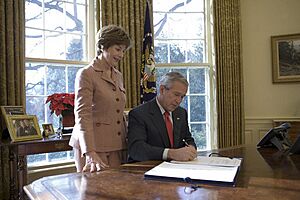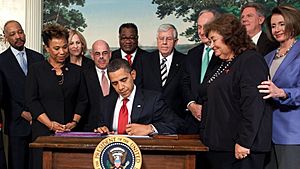Ryan White CARE Act facts for kids
 |
|
| Long title | An Act to amend the Public Health Service Act to provide grants to improve the quality and availability of care for individuals and families affected by HIV, and for other purposes. |
|---|---|
| Nicknames |
|
| Enacted by | the 101st United States Congress |
| Effective | August 18, 1990 |
| Citations | |
| Public law | 101-381 |
| Statutes at Large | 104 Stat. 576 |
| Codification | |
| Titles amended | 42 U.S.C.: Public Health and Social Welfare |
| U.S.C. sections created | 42 U.S.C. ch. 6A, subch. XXIV § 300ff et seq. |
| U.S.C. sections amended | 42 U.S.C. ch. 6A, subch. XXIII § 300ee et seq. |
| Legislative history | |
|
|
The Ryan White Comprehensive AIDS Resources Emergency Act, often called the Ryan White CARE Act, is a very important law in the United States. It is the largest program funded by the government that helps people living with HIV/AIDS. This law makes sure that people with low incomes, or those without enough health insurance, can get the medical care they need.
The act is named after Ryan White, a teenager from Indiana. He got HIV from a blood transfusion when he was 13 years old in 1984. Sadly, he was not allowed to go to school because of his illness. Ryan became a well-known speaker for AIDS research and awareness. He helped teach people about HIV until he passed away in 1990 at age 18.
Contents
How the Ryan White Program Helps
The Ryan White programs act as a "payer of last resort." This means they provide funding for treatment when no other money or resources are available. As the number of people with AIDS grew, the funding for this program also increased.
In 1991, the first year the program received money, about $220 million was spent. By the early 2000s, this amount had grown almost ten times larger. The law has been updated and renewed several times, in 1996, 2000, 2006, and 2009.
This program helps around 500,000 people each year. In 2004, it gave money to 2,567 different organizations. The Ryan White programs also support local doctors and clinics. They help train healthcare workers and offer advice to these organizations.
Funding for Medications
In 2005, the government provided $2.1 billion for the Ryan White CARE Act. About one-third of this money went to programs called AIDS Drug Assistance Programs (ADAP). These programs provide medicines for about 30 percent of people living with HIV.
The main goal of ADAP is to give out FDA-approved prescription medications. These are important for managing HIV. The Ryan White CARE Act also makes sure that emergency medical workers can find out if they were exposed to serious diseases while helping patients.
Lives Saved by the Program
Experts believe that the Ryan White CARE Act has saved many lives. One estimate suggests that the program saved 57,000 lives by 2018. This shows how important the program is for people living with HIV/AIDS in the United States.
Understanding Waiting Lists for Care
For many years in the 2000s, some states had waiting lists for their Ryan White HIV/AIDS Program (RWHAP) Part B programs, especially ADAPs. This meant that people with HIV who needed financial help for their medicines had to wait.
These waiting lists happened because there wasn't enough money to help everyone who needed it. The demand for ADAP services grew faster than the funding from Congress.
How Funding Works
Unlike some other government programs, state ADAP programs get their money through special grants. This means Congress decides how much money to give each year. The amount each state gets depends on how many people with HIV live there.
During the 2000s, states across the U.S. had waiting lists. Some lists had just a few people, while others had hundreds. Some states even stopped accepting new applications or added their own rules for who could get help.
People who needed help with their medicines faced delays in getting care. These delays were very serious. By 2017, almost all ADAP waiting lists were gone. This happened because of new funding and special money from Congress between 2010 and 2013.
Updates to the Ryan White Act
The Ryan White Care Act has been updated several times to make sure it continues to help people. These updates are called reauthorizations.
2006 Changes to the Act

The Ryan White Care Act was supposed to be updated at the end of 2005. However, Congress needed more time to agree on changes. So, the act was extended for one year under its old rules.
Then, in 2006, the act was updated for three more years, until September 30, 2009. It received $2.1 billion in funding. Before this update, money was given out based on the number of people with an AIDS diagnosis in each area. The 2006 update changed this. It also started to consider the number of people living with HIV who did not yet have an AIDS diagnosis.
A big part of the funding goes to emergency relief for certain cities. The 2006 update also changed how these cities were defined. Now, cities with a population greater than 50,000 could qualify, instead of the previous rule of 500,000.
2009 Extension of the Act

In 2009, Congress passed the Ryan White HIV/AIDS Treatment Extension Act. President Obama signed this bill into law on October 30, 2009. This law extended the Ryan White Care Act for another four years.
The Act Today
The Ryan White CARE Act officially expired in 2013. However, the program still exists. Congress continues to provide funding for it each year. This means the important work of helping people with HIV/AIDS continues.
Special Projects of National Significance
The Special Projects of National Significance (SPNS) program is part of the United States Department of Health and Human Services. This program helps to improve knowledge and skills in health and support services. It focuses on helping people with HIV who live in underserved areas.
The SPNS program started in 1991 with several government grants. Today, it has many grants that work on different issues in HIV care.

